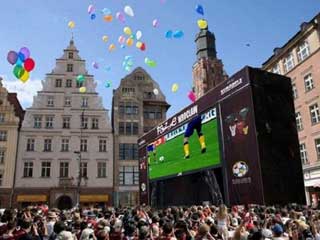Virtual Stadiums
The idea to watch the game without attending a stadium was probably born together with first TV sets. Neighbours would gather in front of a tiny black and white displays to support their favourite team. Once the novel technology of large digital screens (initially, lamp screens, later – LED screens) was developed, the groups gathering in front of outdoor displays in city squares grew in size.
Long ago we reported events of the far away 1998 in an article “Football live on a large outdoor screen in Moscow” when a “live” soccer match was displayed on one of the first screens in Moscow at Poklonnaya Gora. Compared to modern screens that lamp screen was extremely primitive: with acceptable size of 8x6 meters it had the resolution of only 112x84 and pixel pitch of 76,2 mm. This however was a unique event, first one of its kind. The LED technology was making first timid steps forward trying on new applications.
 |
 |
| Big LED Screen at Fan Fest in Frankfurt (2006) Photo credit: Kcsozou |
LED screen at Munsterplatz Fanzone - Euro 2008 (Basel) Photo credit: oleole.com |
By the World Cup in Japan and Korea in 2002 the situation changed drastically. Then the groups of fans gathered during the championship in unofficially created zones for public viewing on large outdoor screens. Before that people could visit sports bars and enjoy an interesting game in the energetic atmosphere of a crowded bar and in a cosy company of friends and a glass of beer. But sports bars with their noisy camaraderie pale in comparison with the modern fan zones where thousands of people watch games on gigantic LED screens.
 |
 |
| Watching France v Romania on LED screen in Bern fan zone, 10 June 2008 Photo credit: oleole.com |
Big LED screen in Manchester fan zone, 2010 Photo credit: menmedia.co.uk |
The first official “fan zone” was set up four years later during the World Cup in Germany, and it was an instant success. The Zone created in 2006 was attended by an impressive 5 million people. Thousands of people cheered their favourite teams during the UEFA Euro 2008 in Austria and Switzerland. At that time 13 sites with large LED screens (with total viewing area of 1200 sq. meters) were set up in Austria, Germany and the Netherlands.
 |
 |
| Cape Town Fan Park FIFA 2010 LED screen | The official FIFA 2010 Fan Fest with LED screen (South Africa) |
An important step in promoting popularity of fan zones was the World Cup in South Africa in June-July 2010. By that time the technology of LED screens was sufficiently mature and sophisticated: tight pixel pitch, new SMD LED technology capable of operating in a protected semi-outdoor environment, state-of-the-art control systems driving HD resolution screens of 100 sq. meters and more, network live broadcasting etc. In South Africa the concept of fan zones expanded to the level of fan parks with huge areas and diverse entertainment. Gigantic LED screens helped a lot in promoting soccer as a game. In fact, from that moment on we can talk about “virtual stadiums”. Fan zones are attended by many more people that can fit in the largest of stadiums.
 |
 |
| Large LED screen in Fan Zone - Euro 2012 in Wroclaw Photo credit: polishguide2012.pl |
Giant LED screen of Fan Zone Euro 2012 in Warsaw Photo credit: warszawa.pl |
The number of fan zones set up specially for the current (June 2012) Euro Cup is not easy to count. Practically in every large city of Europe there are special areas for fans where the leading role is played by LED screens. For example, in Kiev, capital of the host country Ukraine, the main fan zone features four huge LED screens and six smaller perimeter screens. Apart from the actual European Championship's games, LED screens display useful information, announcements, advertising and reels about culture and traditions of Ukraine for the benefit of thousands of tourists.
 |
 |
| LED screens in fan zone - Euro 2012 in Gdansk Photo credit: misja21.blox.pl |
Euro 2012 fans watch the Italy-Spain game on fan zone LED screen in Kiev, Ukraine Photo credit: Anatolii Stepanov / Reuters |
Halfway through the Championship the total number of fans who attended 8 fan zones in Poland and Ukraine (the cities of Warsaw, Gdansk, Poznan, Wroclaw, Kiev, Kharkov, Donetsk, Lvov) exceeded 4 million people. Major fan zones today have more than one LED screen: at Maidan Nezalezhnosti (Independence Square) in Kiev there are 4 gigantic screens, in Warsaw – 6, in Wroclaw – 3, in Donetsk – 3, in Kharkov – 3. In Ukraine fan zones boast record attendance figures. Ukrainian fan zones attracted more than 5 million people, and the fan zone in Kiev – nearly 3 million.
 |
 |
| An LED screen in the Euro 2012 fan zone in Donetsk (Ukraine) Photo credit: donbass.ua |
An LED screen in the Euro 2012 fan zone in Kharkov (Ukraine) Photo credit: life.comments.ua |
All LED screens installed in the above fan zone are more than 100 sq. meters so people may watch the games from far away. The fabulous entertainment programs, performances by famous actors and singers, invited VIPs – all this turns the attendance of fan zones into an unforgettable event. Sponsors love it! Fans love it! Whatever country wins the Championship, the major victory goes to LED screens!





